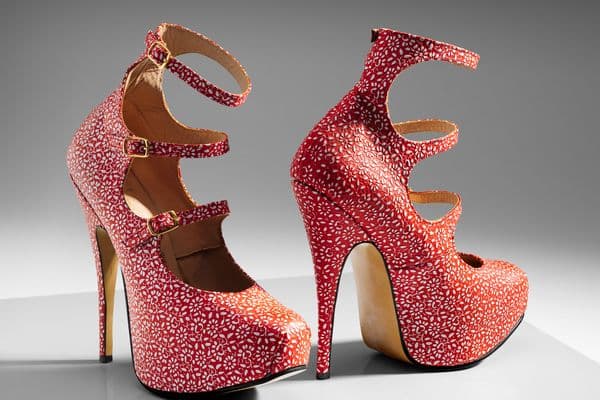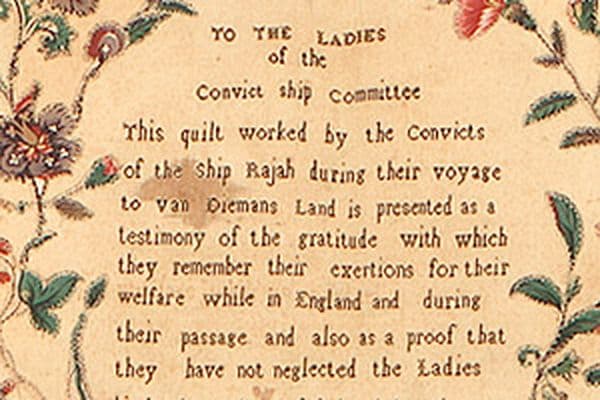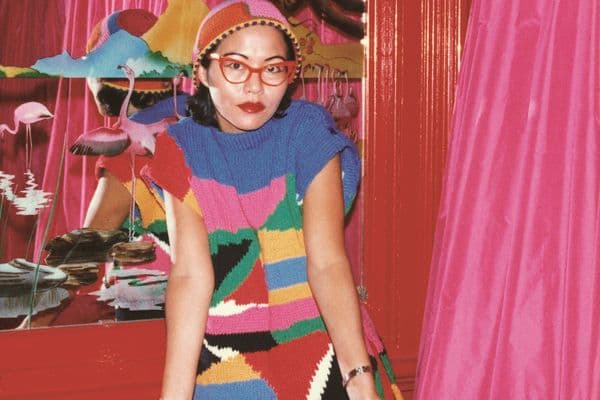Victorian state of mind: Mass reproduction and mythmaking in 1887

Mary Ann Bruton, Quilt 1873–87 (front), pieced medallion style: cotton twill and braid, fine plain weave printed cotton (lining), cotton thread; machine appliquéd, hand and machine stitched. National Gallery of Australia collection, Kamberri/Canberra, purchased 1990
ALICE REZENDE traces the pervasiveness of Queen Victoria’s imagery across historical quilts in the national collection.
In the realm of decorative arts and design, material imprints from the late Victorian era stand out due the ubiquitous use of images of Great Britain’s Queen Alexandrina Victoria (1819–1901). From her coronation in 1838 at the age of nineteen, ‘her Majesty … a great Sovereign … and Empress’1 captured the public imagination. As her reign overlapped the Industrial Revolution, Victoria came to stand as a symbol for the prosperity, unity and technological and scientific advancements of the British Empire and its extended colonial settlements across the globe including Australia, North America, India, the West Indies, Southeast Asia, Africa, and more.2
///national-gallery-of-australia/media/dd/images/illustrated_london_news_june_23_1887_p_721_copy.jpg)
The Illustrated London News, June 25, 1887, p 721, HathiTrust Digital Library 2024, public domain

Unknown, Bed cover c 1838, Victoria and Albert Museum collection, London, © Victoria and Albert Museum. This quilted bed cover features a commemorative textile central medallion showing two repeating images of the 1838 coronation of Queen Victoria in Westminster Abbey.
The use and reproduction of images of Queen Victoria in Australia was particularly significant since most settlers were British subjects, and the country still a series of small colonies — though land had never been ceded by its First Nations peoples — with major power still resting with the British government. Although Australian decorative arts such as pottery, furniture and silver began to show indigenous symbols such as kangaroos, emus and native flowers as early as the 1840s, quiltmakers — particularly those who identified as ‘gentle’ middle class women — continued to identify with their British origins.3
Following her husband Prince Albert’s death in 1861 from typhoid fever, the Queen had forgone celebrations to mark her 25th year of rule in 1862 and had since continued to avoid official occasions, devoting her time primarily to her family.4 Commemorating 50 years of Her Majesty’s service, Queen Victoria’s Golden Jubilee of 1887 thus became a highly anticipated public event. In South Australia, the Adelaide Exhibition Building was formally opened as the site of the Adelaide International Jubilee Exhibition of 1887. Newspapers across the country announced celebrations including town illuminations, medal presentations for children and military band performances, with Melbourne’s The Leader anticipating that ‘the 20th June, 1887, may be the anniversary to be honored: it will shed long rays behind and in front.’5

‘Preparing for the Jubilee: Buying flags and Chinese lanterns’, The Illustrated London News, June 18, 1887, p 691, HathiTrust Digital Library 2024, public domain.
https://hdl.handle.net/2027/chi.39519050
The 1887 Golden Jubilee was the first royal event for which large quantities of souvenirs were mass-produced for the public, and the image of Queen Victoria memorably imprinted on thousands of manufactured objects. Made from ceramic, pressed glass and metal, they included an impressive array of items such as cups, mugs and plates, pin trays, sugar bowls and candlesticks, brooches, bracelets and medallions, books, Jubilee procession programs, sheet music, silk bookmarks, printed cotton handkerchiefs, clay pipes and, last but not least, commemorative newspaper and magazine supplements.6 An example of the latter is the 13 June 1887 Royal Jubilee issue of the Illustrated London News, which included a full-length portrait reproduction of Queen Victoria by Austrian artist Baron Heinrich Von Angeli among its many full-page illustrations.7
While the repeated print found on the backing fabric of Mary Bruton’s Quilt 1873–87 bears a strong resemblance to this portrait, a closer examination shows that the exact work replicated in the print was another Angeli portrait commissioned by the royal family, Queen Victoria 1890 (Osborne House, Royal Collection Trust). In this three-quarter bust image, Victoria wears a large diamond necklace and the small diamond crown she commissioned in 1870 to be worn above her widow’s cap.8 Like souvenir manufacturers, textile printers understood the lucrative potential of the Golden Jubilee, producing many roller-printed cottons often of reduced design and print quality. The prevalence of these historical fabrics in Australian and North American collections suggest they were made primarily for export markets.9
Born in lutruwita/Tasmania but the daughter of English immigrants, Mary Ann Bruton (née Holley) (1851–1930) raised her children and worked as a local dressmaker on Dja Dja Wurrung and Taungurung Country/Sandhurst, now Bendigo, from 1873. Mary Ann began work on the quilt from this time, completing it after her family’s move to Matakupaat/Swan Hill in 1885. In choosing this commemorative print, Bruton shows her embrace of a Victorian way of life through the morals and values personified in the myth-like image of Queen Victoria: domesticity, motherhood, thrift, and dignity. In this way, we can see how Victorian values blended the spheres of the private and the public: for Queen Victoria’s authority as a monarch was inextricably linked to her domestic identity as a devoted mother, wife and widow.10
'In ordinary private life we may now and then contemplate so large and full a development of the family, the basis of human society, the source of the purest pleasures, the strongest motive to good conduct, the most precious treasure of mortal existence. In Royal life it is extremely rare … We owe it, in a great measure, to the character of Queen Victoria, and to her education of her sons and daughters … '
THE ILLUSTRATED LONDON NEWS,
25 JUNE, 1887

Mary Ann Bruton, Quilt 1873–87 (front), pieced medallion style: cotton twill and braid, fine plain weave printed cotton (lining), cotton thread; machine appliquéd, hand and machine stitched. National Gallery of Australia collection, Kamberri/Canberra, purchased 1990

Mary Ann Bruton, Quilt 1873–87 (back lining), National Gallery of Australia collection, Kamberri/Canberra.

Mary Ann Bruton, Quilt 1873–87 (detail: back lining), National Gallery of Australia collection, Kamberri/Canberra
Made by the Hampson women11 in lutruwita/Tasmania, The Westbury quilt 1900–03 further illustrates the mythological impact of Victoria’s image on the public consciousness. The Westbury quilt is undisputedly significant due to its ability to reflect local personages and lores through rich and narrative embroidered depictions of the Hampson family’s pet animals, farm life, personal tragedies and local happenings. Yet also evident is the dedicated place reserved for symbols of Great Britain and depictions of the Queen, the latter who is placed at the centre of the quilt in full royal regalia underneath the words ‘Victoria the Good 1900’. Her image, much like in Bruton’s Quilt, is surrounded by the Tudor rose, shamrock and thistle, emblematic of England, Ireland and Scotland respectively. Unlike the first work, however, here the Queen is carefully and deliberately constructed by the maker’s hand and not merely a pre-manufactured print fabric. The British coat of arms appears three times, and a prominent image of the British lion is stitched on the upper right section, foregrounded by the opening verses of The British lion, a patriotic song lauding Britain’s noble yet fierce and dominating character.

Mary Ann Hampson, Mary Hampson, Hannah/Anna Hampson, Isabella Hampson, Evangeline Hampson, Jane Hampson, The Westbury quilt (detail) 1900–03, National Gallery of Australia collection, Kamberri/Canberra, purchased through the Australian Textiles Fund 1990

Mary Ann Hampson, Mary Hampson, Hannah/Anna Hampson, Isabella Hampson, Evangeline Hampson, Jane Hampson, The Westbury quilt (detail) 1900–03, National Gallery of Australia collection, Kamberri/Canberra, purchased through the Australian Textiles Fund 1990.
This pervasive sense of loyalty to the Crown on the part of early Australian ‘gentle’ women settlers is perhaps not so difficult to untangle, particularly given Victoria’s reclusiveness and domesticity, which appeared at odds with her role as the leader of the Empire. Beyond good old-fashioned patriotism, it could be surmised that these women favoured Victoria’s imagery because their identity — as mothers, grandmothers, wives and widows — aligned with the Queen’s more closely than most. Paradoxically, in this domestic reflection they also saw what they perceived to be their societal purpose: nation-building through gentle skills, industriousness in the home and the unity of family.
A Century of Quilts is on display from 16 March – 25 August 2024.












